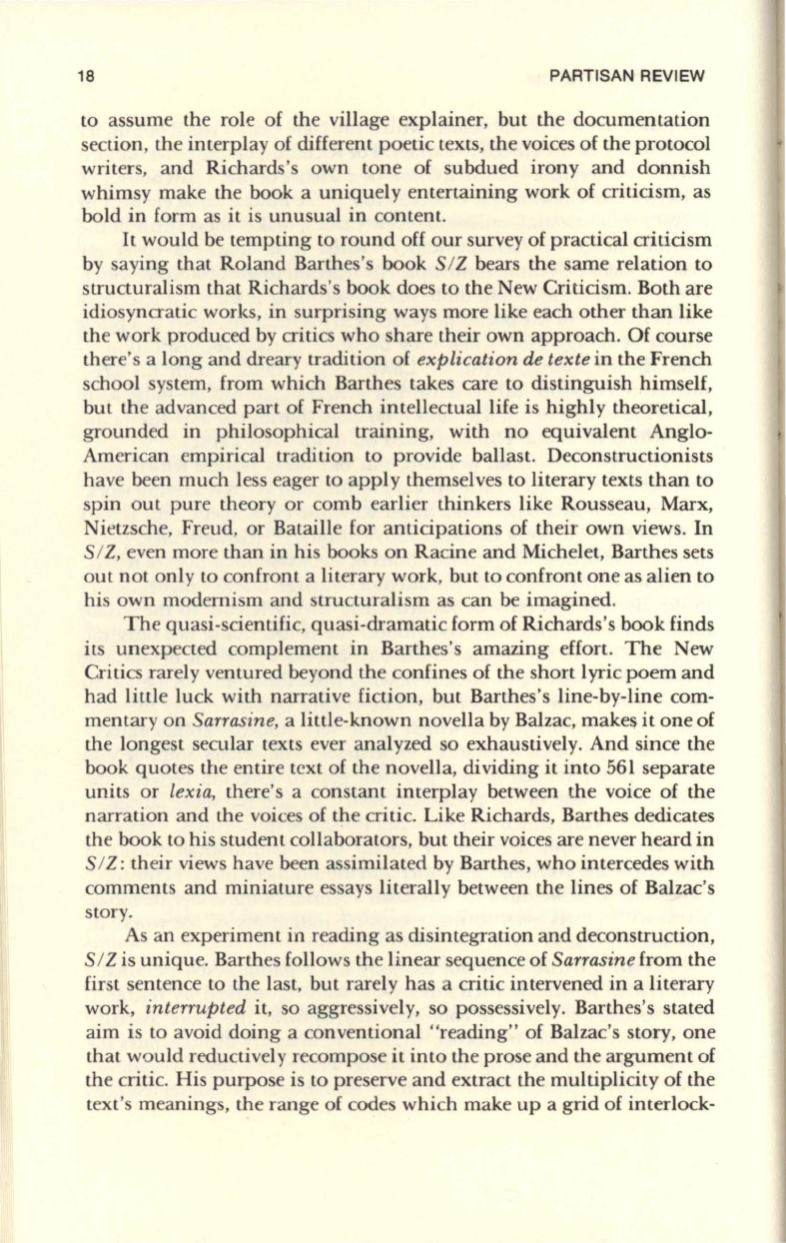
18
PARTISAN REVIEW
to assume the role of the village explainer, but the documentation
section, the interplay of different poetic texts, the voices of the protocol
writers, and Richards 's own tone of subdued irony and donnish
whimsy make the book a uniquely entertaining work of criticism, as
bold in form as it is unusual in content.
It would be tempting to round off our survey of practical criticism
by saying that Roland Barthes's book
S i l
bears the same relation to
structuralism that Richards's book does to the New Criticism. Both are
idiosyncratic works, in surprising ways more like each other than like
the work produced by critics who share their own approach. Of course
there's a long and dreary tradition of
explication de texte
in the French
school system, from which Barthes takes care to distinguish himself,
but the advanced part of French intellectual life is highly theoretical,
grounded in philosophical training, with no equivalent Anglo–
American empirical tradition to provide ballast. Deconstructionists
have been much less eager to apply themselves to literary texts than to
spin out pure theory or comb earlier thinkers like Rousseau, Marx,
Nietzsche, Freud, or Bataille for anticipations of their own views. In
S l l,
even more than in his books on Racine and Michelet, Barthes sets
out not only to confront a literary work, but to confront one as alien to
his own modernism and structuralism as can be imagined.
The quasi-scientific, quasi-dramatic form of Richards's book finds
its unexpected complement in Barthes's amazing effort. The New
Critics rarely ventured beyond the confines of the short lyric poem and
had little luck with narrative fiction, but Barthes's line-by-line com–
mentary on
Sarrasine,
a little-known novella by Balzac, make!! it one of
the longest secular texts ever analyzed so exhaustively. And since the
book quotes the entire text of the novella, dividing it into 561 separate
units or
lexia,
there's a constant interplay between the voice of the
narration and the voices of the critic. Like Richards, Barthes dedicates
the book to his student collaborators, but their voices are never heard in
S l l :
their views have been assimilated by Barthes, who intercedes with
comments and miniature essays literally between the lines of Balzac's
story.
As an experiment in reading as disintegration and deconstruction,
S I
l
is unique. Barthes follows the linear sequence of
Sarrasine
from the
first sentence to the last, but rarely has a critic intervened in a literary
work,
interrupted
it, so aggressively, so possessively. Barthes's stated
aim is to avoid doing a conventional "reading" of Balzac's story, one
that would reductively recompose it into the prose and the argument of
the critic. His purpose is to preserve and extract the multiplicity of the
text's meanings, the range of codes which make up a grid of interlock-


